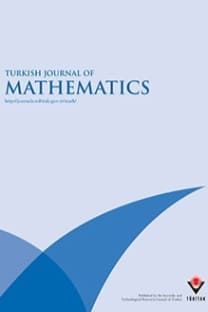An asymptotic-numerical hybrid method for singularly perturbed system of two-point reaction-diffusion boundary-value problems
An asymptotic-numerical hybrid method for singularly perturbed system of two-point reaction-diffusion boundary-value problems
___
- [1] Ayaz F. Solutions of the system of differential equations by differential transform method. Appl Math Comput 2004; 147: 547-567.
- [2] Bellew S, O’Riordan E. A parameter robust numerical method for a system of two singularly perturbed convectiondiffusion equations. Appl Numer Math 2004; 51: 171-186.
- [3] Biazar J, Babolian E, Islam R. Solution of the system of ordinary differential equations by Adomian decomposition method. Appl Math Comput 2004; 147: 713-719.
- [4] Cengizci S, Atay MT, Eryilmaz A. A uniformly valid approximation algorithm for nonlinear ordinary singular perturbation problems with boundary layer solutions. Springerplus 2016; 5: 280.
- [5] Cengizci S, Eryılmaz A. Successive complementary expansion method for solving Troesch’s problem as a singular perturbation problem. Int J Eng Math 2015; 2015: 949463.
- [6] Cousteix J, Mauss J. Asymptotic Analysis and Boundary Layers. Scientific Computation, Vol. XVIII. Berlin, Germany: Springer, 2007.
- [7] Cui M, Geng F. Solving singular two-point boundary value problem in reproducing kernel space. J Comput Appl Math 2007; 205: 6-15.
- [8] Das, P, Natesan, S. Optimal error estimate using mesh equidistribution technique for singularly perturbed system of reaction-diffusion boundary-value problems. Appl Math Comput 2014; 249: 265-277.
- [9] Farrell PA, Hegarty AF, Miller JJH, O’Riordan E, Shishkin GI. Robust Computational Techniques for Boundary Layers. Boca Raton, FL, USA: Chapman & Hall/CRC, 2000.
- [10] Gracia JL, Lisbona FJ, O’Riordan E. A coupled system of singularly perturbed parabolic reaction-diffusion equations. Adv Comput Math 2010; 32: 43-61.
- [11] Hirsch MW, Smale S, Devaney RL. Differential Equations, Dynamical Systems, and an Introduction to Chaos. Amsterdam, the Netherlands: Elsevier, 2004.
- [12] Kadalbajoo MK, Gupta V. A brief survey on numerical methods for solving singularly perturbed problems. Appl Math Comput 2010; 217: 3641-3716.
- [13] Kadalbajoo MK, Reddy YN. Numerical treatment of singularly perturbed two point boundary value problems. Appl Math Comput 1987; 21: 93-110.
- [14] Kevorkian JK, Cole JD. Multiple Scale and Singular Perturbation Methods. Vol. 114. New York, NY, USA: Springer Science & Business Media, 2012.
- [15] Kierzenka J, Shampine LF. A BVP solver based on residual control and the Maltab PSE. ACM T Math Software 2001; 27: 299-316.
- [16] Kumar M. Methods for solving singular perturbation problems arising in science and engineering. Math Comput Model 2011; 54: 556-575.
- [17] Kumar M, Mishra HK. Variational iteration method for a singular perturbation boundary value problems. Am J Numer Anal 2014; 2: 102-106.
- [18] Lin R, Stynes M. A balanced finite element method for a system of singularly perturbed reaction-diffusion two-point boundary value problems. Numer Algorithms 2015; 70: 691-707.
- [19] Linß T, Madden N. A finite element analysis of a coupled system of singularly perturbed reaction-diffusion equations. Appl Math Comput 2004; 148: 869-880.
- [20] Linß T. Analysis of an upwind finite-difference scheme for a system of coupled singularly perturbed convectiondiffusion equations. Computing 2007; 79: 23-32.
- [21] Matthews S, O’Riordan E, Shishkin GI. A numerical method for a system of singularly perturbed reaction-diffusion equations. J Comput Appl Math 2002; 145: 151-166.
- [22] Mauss J, Cousteix J. Uniformly valid approximation for singular perturbation problems and matching principle. CR Mécanique 2002; 330: 697-702.
- [23] Miller JJH, O’Riordan E, Shishkin GI. Fitted Numerical Methods for Singular Perturbation Problems: Error Estimates in the Maximum Norm for Linear Problems in One and Two Dimensions. Singapore: World Scientific, 2012.
- [24] Natesan S, Deb BS. A robust computational method for singularly perturbed coupled system of reaction-diffusion boundary-value problems. Appl Math Comput 2007; 188: 353-364.
- [25] Paramasivam M, Miller JJH, Valarmathi S. Second order parameter-uniform numerical method for a partially singularly perturbed linear system of reaction-diffusion type. Math Commun 2013; 18: 271-295.
- [26] Robert E Jr. Singular Perturbation Methods for Ordinary Differential Equations. Vol. 89. New York, NY, USA: Springer Science & Business Media, 2012.
- [27] Tamilselvan A, Ramanujam N, Shanthi V. A numerical method for singularly perturbed weakly coupled system of two second order ordinary differential equations with discontinuous source term. J Comput Appl Math 2007; 202: 203-216.
- [28] Valanarasu T, Ramanujam N. An asymptotic initial value method for boundary value problems for a system of singularly perturbed second order ordinary differential equations. Appl Math Comput 2004; 147: 227-240.
- [29] Verhulst F. Methods and Applications of Singular Perturbations: Boundary Layers and Multiple Timescale Dynamics. Vol. 50. New York, NY, USA: Springer Science & Business Media, 2005.
- [30] Vigo-Aguiar J, Natesan S. An efficient numerical method for singular perturbation problems. J Comput Appl Math 2006; 192: 132-141.
- ISSN: 1300-0098
- Yayın Aralığı: 6
- Yayıncı: TÜBİTAK
Categorical structures of Lie–Rinehart crossed module
A broken cycle theorem for the restrained chromatic function
Changjun HUANG, Hongmei XIA, XIKE ZHANG
On the composition and exterior products of double forms and p-pure manifolds
Abdelhadi BELKHIRAT, Mohammed LABBI
Sedat AKLEYLEK, Meryem SOYSALDI
The X-coordinates of Pell equations and Padovan numbers
Salah Eddine RIHANE, Mohand Ouamar HERNANE, Alain TOGBE
Abdelhadi BELKHIRAT, Mohammed LABBI
Abdoreza ARMAKAN, Sergei SILVESTROV, Mohammad Reza FARHANGDOOST
Takao KOMATSU, Amalia PİZARRO-MADARİAGA
Weighted composition operators between vector-valued Bloch-type spaces
